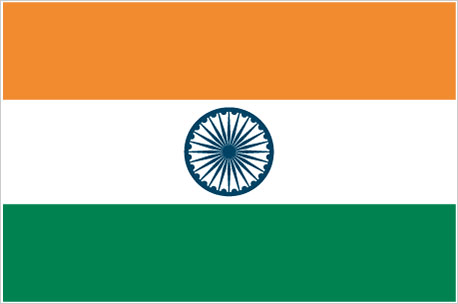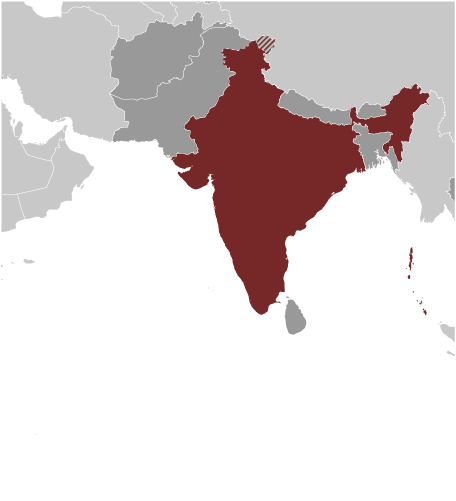|
Country name:
|

|
|
conventional long form: Republic of India
conventional short form:
India
local long form:
Republic of India/Bharatiya Ganarajya
local short form:
India/Bharat
|
|
|
Government type:
|

|
|
federal republic
|
|
|
Capital:
|

|
|
name: New Delhi
geographic coordinates:
28 36 N, 77 12 E
time difference:
UTC+5.5 (10.5 hours ahead of Washington, DC during Standard Time)
|
|
|
Administrative divisions:
|

|
|
28 states and 7 union territories*; Andaman and Nicobar Islands*, Andhra Pradesh, Arunachal Pradesh, Assam, Bihar, Chandigarh*, Chhattisgarh, Dadra and Nagar Haveli*, Daman and Diu*, Delhi*, Goa, Gujarat, Haryana, Himachal Pradesh, Jammu and Kashmir, Jharkhand, Karnataka, Kerala, Lakshadweep*, Madhya Pradesh, Maharashtra, Manipur, Meghalaya, Mizoram, Nagaland, Odisha, Puducherry*, Punjab, Rajasthan, Sikkim, Tamil Nadu, Tripura, Uttar Pradesh, Uttarakhand, West Bengal
note:
although its status is that of a union territory, the official name of Delhi is National Capital Territory of Delhi
|
|
|
Independence:
|

|
|
15 August 1947 (from the UK)
|
|
|
National holiday:
|

|
|
Republic Day, 26 January (1950)
|
|
|
Constitution:
|

|
|
26 January 1950; amended many times
|
|
|
Legal system:
|

|
|
common law system based on the English model; separate personal law codes apply to Muslims, Christians, and Hindus; judicial review of legislative acts
|
|
|
International law organization participation:
|

|
|
accepts compulsory ICJ jurisdiction with reservations; non-party state to the ICCt
|
|
|
Suffrage:
|

|
|
18 years of age; universal
|
|
|
Executive branch:
|

|
|
chief of state: President Pranab MUKHERJEE (since 22 July 2012); Vice President Mohammad Hamid ANSARI (since 11 August 2007)
head of government:
Prime Minister Manmohan SINGH (since 22 May 2004)
cabinet:
Union Council of Ministers appointed by the president on the recommendation of the prime minister
(For more information visit the World Leaders website  ) )
elections:
president elected by an electoral college consisting of elected members of both houses of Parliament and the legislatures of the states for a five-year term (no term limits); election last held in July 2012 (next to be held in July 2017); vice president elected by both houses of Parliament for a five-year term; election last held in August 2012 (next to be held in August 2017); prime minister chosen by parliamentary members of the majority party following legislative elections; election last held April - May 2009 (next to be held no later than May 2014)
election results:
Pranab MUKHERJEE elected president; percent of vote - Pranab MUKHERJEE 69.31%, Purno SANGMA - 30.69%
|
|
|
Legislative branch:
|

|
|
bicameral Parliament or Sansad consists of the Council of States or Rajya Sabha (a body consisting of 245 seats up to 12 of which are appointed by the president, the remainder chosen in staggered elections by the elected members of the state and territorial assemblies; members serve six-year terms) and the People's Assembly or Lok Sabha (545 seats; 543 members elected by popular vote, 2 appointed by the president; members serve five-year terms)
elections:
People's Assembly - last held in five phases on 16, 22-23, 30 April and 7, 13 May 2009 (next must be held by May 2014)
election results:
People's Assembly - percent of vote by party - NA; seats by party - INC 206, BJP 116, SP 23, BSP 21, JD(U) 20, TMC 19, DMK 18, CPI(M) 16, BJD 14, SS 11, AIADMK 9, NCP 9, TDP 6, RLD 5, CPI 4, RJD 4, SAD 4, independent 9, other 29, vacant 2; note - seats by party (as of February 2013) - INC 204, BJP 115, SP 22, BSP 21, JD(U) 20, AITC 19, DMK 18, CPI(M) 16, BJD 14, SS 11, AIADMK 9, NCP 9, TDP 6, RLD 5, CPI 4, RJD 4, SAD 4, independents 9, other 31, nominated (INC) 2, vacant 2
|
|
|
Judicial branch:
|

|
|
Supreme Court (one chief justice and 25 associate justices are appointed by the president and remain in office until they reach the age of 65 or are removed for "proved misbehavior")
|
|
|
Political parties and leaders:
|

|
|
Aam Aadmi Party or AAP [Arvind KEJRIWAL]; All India Anna Dravida Munnetra Kazhagam or AIADMK [J. JAYALALITHAA]; All India Trinamool Congress or TMC [Mamata BANERJEE]; Bahujan Samaj Party or BSP [MAYAWATI]; Bharatiya Janata Party or BJP [Rajnath SINGH]; Biju Janata Dal or BJD [Naveen PATNAIK]; Communist Party of India or CPI [A.B. BARDHAN]; Communist Party of India-Marxist or CPI(M)[Prakash KARAT]; Dravida Munnetra Kazhagam or DMK [M.KARUNANIDHI]; Indian National Congress or INC [Sonia GANDHI]; Janata Dal (United) or JD(U) [Sharad YADAV]; Nationalist Congress Party or NCP [Sharad PAWAR]; Rashtriya Janata Dal or RJD [Lalu Prasad YADAV]; Rashtriya Lok Dal or RLD [Ajit SINGH]; Samajwadi Party or SP [Mulayam Singh YADAV]; Shiromani Akali Dal or SAD [Parkash Singh BADAL]; Shiv Sena or SS [Uddhav THACKERAY]; Telugu Desam Party or TDP [Chandrababu NAIDU]; note - India has dozens of national and regional political parties; only parties with four or more seats in the People's Assembly are listed
|
|
|
Political pressure groups and leaders:
|

|
|
All Parties Hurriyat Conference in the Kashmir Valley (separatist group); Bajrang Dal (religious organization); India Against Corruption [Anna HAZAREI]; Jamiat Ulema-e Hind (religious organization); Rashtriya Swayamsevak Sangh [Mohan BHAGWAT] (religious organization); Vishwa Hindu Parishad [Ashok SINGHAL] (religious organization)
other:
numerous religious or militant/chauvinistic organizations; various separatist groups seeking greater communal and/or regional autonomy; hundreds of social reform, anti-corruption, and environmental groups at state and local level
|
|
|
International organization participation:
|

|
|
ABEDA, ADB, AfDB (nonregional member), ARF, ASEAN (dialogue partner), BIMSTEC, BIS, BRICS, C, CD, CERN (observer), CICA, CP, EAS, FAO, FATF, G-15, G-20, G-24, G-77, IAEA, IBRD, ICAO, ICC (national committees), ICRM, IDA, IFAD, IFC, IFRCS, IHO, ILO, IMF, IMO, IMSO, Interpol, IOC, IOM, IPU, ISO, ITSO, ITU, ITUC (NGOs), LAS (observer), MIGA, MONUSCO, NAM, OAS (observer), OECD, OPCW, PCA, PIF (partner), SAARC, SACEP, SCO (observer), UN, UNCTAD, UNDOF, UNESCO, UNHCR, UNIDO, UNIFIL, UNISFA, UNITAR, UNMISS, UNOCI, UNSC (temporary), UNWTO, UPU, WCO, WFTU (NGOs), WHO, WIPO, WMO, WTO
|
|
|
Diplomatic representation in the US:
|

|
|
chief of mission: Ambassador Nirupama RAO
chancery:
2107 Massachusetts Avenue NW, Washington, DC 20008; note - Consular Wing located at 2536 Massachusetts Avenue NW, Washington, DC 20008
telephone:
[1] (202) 939-7000
FAX:
[1] (202) 265-4351
consulate(s) general:
Atlanta, Chicago, Houston, New York, San Francisco
|
|
|
Diplomatic representation from the US:
|

|
|
chief of mission: Ambassador Nancy J. POWELL
embassy:
Shantipath, Chanakyapuri, New Delhi 110021
mailing address:
use embassy street address
telephone:
[91] (11) 2419-8000
FAX:
[91] (11) 2419-0017
consulate(s) general:
Chennai (Madras), Hyderabad; Kolkata (Calcutta), Mumbai (Bombay)
|
|
|
Flag description:
|

|
|
three equal horizontal bands of saffron (subdued orange) (top), white, and green, with a blue chakra (24-spoked wheel) centered in the white band; saffron represents courage, sacrifice, and the spirit of renunciation; white signifies purity and truth; green stands for faith and fertility; the blue chakra symbolizes the wheel of life in movement and death in stagnation
note:
similar to the flag of Niger, which has a small orange disk centered in the white band
|
|
|
National symbol(s):
|

|
|
the Lion Capital of Ashoka, which depicts four Asiatic lions standing back to back mounted on a circular abacus, is the official emblem; the Bengal tiger is the national animal
|
|
|
National anthem:
|

|
|
name: "Jana-Gana-Mana" (Thou Art the Ruler of the Minds of All People)
lyrics/music:
Rabindranath TAGORE
note:
adopted 1950; Rabindranath TAGORE, a Nobel laureate, also wrote Bangladesh's national anthem
|
|
|
|
|





 )
)



